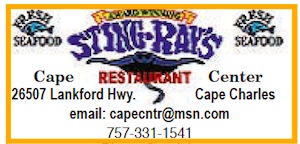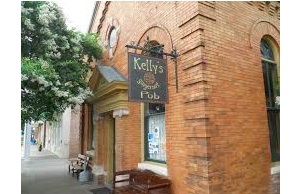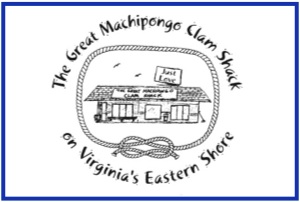In Defense of Meat and Other Animal Products
By KAREN GAY
Wave Columnist
May 4, 2015
This contin ues my previous article about the Weston A. Price Foundation’s dietary principles. I’ll discuss the Foundation’s belief that health is best found in a diet of unprocessed, traditional foods containing some sort of animal product, be it fish, shellfish, fowl, sea mammals, eggs, milk and milk products, or even reptiles or insects. There has been some discussion in the Wave regarding the virtues of a vegetarian diet, and I’d like to provide a gentle rebuttal to those points of view.
ues my previous article about the Weston A. Price Foundation’s dietary principles. I’ll discuss the Foundation’s belief that health is best found in a diet of unprocessed, traditional foods containing some sort of animal product, be it fish, shellfish, fowl, sea mammals, eggs, milk and milk products, or even reptiles or insects. There has been some discussion in the Wave regarding the virtues of a vegetarian diet, and I’d like to provide a gentle rebuttal to those points of view.
Weston A. Price was a dentist born in 1870 who noticed that most people who had serious dental problems also had degenerative health issues. Over the course of 10 years he travelled to study isolated indigenous societies to determine the factors responsible for good dental health. Dr. Price visited tribes in Alaska, Africa, Australia, New Zealand, Peru, and even sequestered villages in Switzerland. After analyzing the foods used by these societies he saw that in comparison to the American diet of the 1930s, they provided at least four times the water soluble vitamins, calcium, and other minerals, and at least 10 times the fat-soluble vitamins — from animal foods such as butter, fish, eggs, shellfish, organ meats, and animal fats.
In his travels he had been hoping to find a society which demonstrated good health solely from fruits and vegetables, but he was disappointed. In his book, Nutrition and Physical Degeneration, he concluded ”As yet, I have not found a single group of primitive racial stock which was building and maintaining excellent bodies by living entirely on plant foods. I have found in many parts of the world most devout representatives of modern ethical systems advocating restriction of foods to the vegetable products. In every instance where the groups involved had been long under this teaching, I found evidence of degeneration in the form of abnormal dental arches to an extent very much higher than in the primitive groups who were not under this influence.”
What about the cruelty issue?
My neighbor, Wayne Creed, spoke eloquently in the Wave of the confined animal feeding operations that produce most of our meat available in traditional grocery stores. I support Wayne in urging people to boycott meat from animals that have not been treated humanely. However, everyone’s definition of what is humane is different. I believe that meat animals should be grown in the natural environment in which they thrive and in populations that do not overwhelm the natural resources of the land. So, to me, this means that cattle are raised in pastures with plenty of fresh green grass, hay, and shelter in the winter. Chickens should be outdoors in the sun pecking for insects, and hogs should free range under the shade of trees where they can dig for tubers and insects. [Read more…]
Strawberry Street Corridor Project and Former Northampton Hotel OK’d by Harbor Review Board
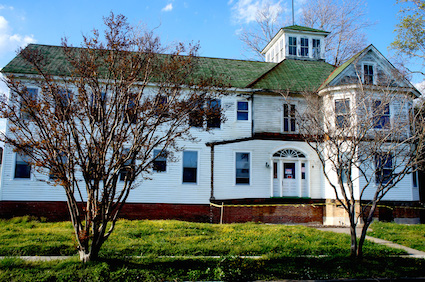
Front porch has been removed from old Northampton Hotel. (Wave photo)
By WAYNE CREED
Cape Charles Wave
April 27, 2015
The Cape Charles Harbor Area Review Board reviewed two high profile projects April 20 — the former Northampton Hotel at 1 Mason Avenue, and Patrick Hand’s Strawberry Street Corridor project. Both projects mean a lot to the rehabilitation and restoration of the Mason Street business district as well as to the overall historic character of Cape Charles itself.
Mr. Hand has applied for a review for new construction of a mixed-use development consisting of 20 one-bedroom residential units above commercial units on the cleared site of the old Meatland building. On April 14 the Board of Zoning Appeals approved four variances to the application after approving a demolition permit last December.
Harbor Area Review Board Chairman Ralph Orso questioned whether the applicant would be able to honor the variances following a VDOT site line inspection. It appeared the project could lose some parking spaces, dropping total parking to 38 or 39 spaces, while 40 spaces are required for the variance. Hand assured the Board that his engineer was working on the issue, and they were confident they would be able to achieve the 40 space total required. “Even with these slight changes, besides all the parking, we are still going to be able to keep the same amount of open and green space,” Hand said.
Board member Joan Natali wanted assurance that utility wires would be buried underground. Hand pointed out in the architectural drawings that not only would the utilities be underground, but that metering equipment would also be concealed inside a room. Natali also voiced concern regarding the roofline, which guidelines require to have a differentiation in height across the façade. Hand noted that due to the design, there was going to be a series of offsets from the façade that, from a “pedestrian perspective,” would provide a good bit of noticeable change in the roofline. [Read more…]
SHORE THING: Eastville Inn Fails Again
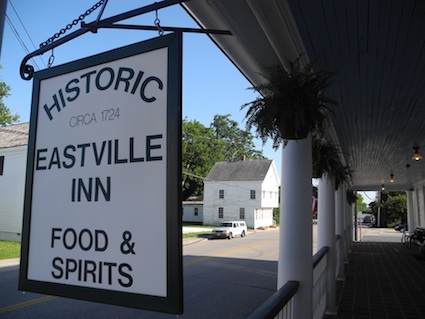
Eastville Inn’s bumpy ride in recent years reflects the difficulty of making a living from running a restaurant on the Eastern Shore.
By GEORGE SOUTHERN
Wave Columnist
April 27, 2015
A little shy of two years ago, Eastville resident and Wave student journalist Sarah Gollibart wrote an article entitled “Eastville Inn Rises Again.” It went on to become one of the Wave’s most-read stories of the year, so I know that a lot of folks are interested in the Eastville Inn.
But after the Inn shut down again on March 24, I started wondering, just what does it take to run a successful restaurant on the lower Eastern Shore? If the Eastville Inn can’t make it, who can – and how?
The Eastville Inn is a good case study because on paper at least it has so much going for it. Start with a historic building (c.1724) in a quaint town. Add proximity to the courthouse and county seat government center. Top it off with a talented chef/owner (Brent Schmidt) who bent over backward to make his venture special and inviting.
So what went wrong? The quick response might be that Chef Schmidt’s nouvelle cuisine wasn’t the local clientele’s cup of tea – either in taste (light), portion (small), or price (high).
But wait a minute – those were some of the same causes attributed to the Eastville Inn’s failure two iterations earlier. Following that shutdown, a local team converted the Inn’s format to kind of an upscale Exmore Diner. But that didn’t work either – the former clientele didn’t like it, and the hoped-for new customers stayed at Yuk’s.
So I’m thinking that the Eastville Inn’s woes are not of its own doing but rather reflective of the whole lower Shore. This is a tough market! Follow me up Route 13 and see what I mean. [Read more…]
Historic District Review Board Approves Projects, Considers Paint Colors and Satellite Dishes
By WAYNE CREED
Cape Charles Wave
April 27, 2015
In 1954, the Supreme Court case of Berman v. Parker set a precedent which allowed local governments to “tear down an old building to improve a neighborhood.” This landmark case oddly led the way for the modern preservation movement.
The case was heard during the beginnings of the urban renewal movement, which sought to rehabilitate blight in America’s cities. Essentially, the ruling implied that aesthetics was enough to finally enforce a historic district’s preservation efforts. That is, a historic district could endeavor to protect historic neighborhoods based on visual importance.
From the early attempts creating historic districts, such as Charleston, Savannah, or New Orleans, several key concepts have evolved, such as to protect significant historic properties against the threat of development, to encourage development in an older area, to maintain property values, or to create a brand or image of the place.
Of course, there is the economic effect. Don Rypkema, in The Economics of Rehabilitation, states that historic reinvestment can generate tax credits and can establish a new and higher depreciation schedule, extend the property’s economic life, and achieve a better quantity, quality, and durability of the income stream. Also, it can stimulate tourism, private, increased property values, property values and sales tax, create jobs and compatible land use patterns.
On April 21, town officials in charge of this preservation effort, the Historic District Review Board, met to revisit the Certificate of Appropriateness for each of two properties, 1 Mason Avenue (The Hotel), and 205 Jefferson Avenue. [Read more…]
LETTER: Chicken Houses Will Lower Property Values
April 27, 2015
EDITOR’S NOTE: Professor Art Schwarzschild submitted the following letter April 20 to the Northampton County Board of Supervisors, asking that it be made public record.
Dear Members of the Northampton County Board of Supervisors, Planning Commission, and County Staff,
I would like to start this letter with an apology for the tone of my last letter which questioned the motivations behind what I saw as the mysterious insertion of the new zoning use, “Event Venue,” into the revised draft zoning proposal. That being said, I believe it is important for you to understand that the back room procedure being used to write and repeatedly tweak the proposed zoning changes with little to no public involvement or explanation has led many Northampton County residents to question the motivations behind the proposed changes.
Once again, I would remind you of the comparison between the procedure used to create our current zoning code and this ongoing and confusing process. During the previous process the public was invited and encouraged to attend zoning work sessions in order to help craft a new comprehensive plan and zoning ordinance. These public work sessions were run by the County Planning Director and Planning Staff with additional support from paid consultants.
Members of the PC and BOS were in attendance at each of these meetings to witness public input. Scientific data, Economic Reports and Case Studies were presented and used as guides to ask citizens what they wanted to see in Northampton County and to help provide a realistic road map for us to achieve these outcomes.
In stark contrast, I have seen no data, surveys, or case studies used to support the multitude of zoning changes being proposed. What’s even worse, these changes have often been presented in a confusing and misleading manner. [Read more…]
LETTER: Lost Foreign Trade Zone Status Is Tragedy
April 27, 2015
DEAR EDITOR,
On October 23, 2012, you published my commentary, Expert Warns Eastern Shore: Special Trade Zone Status Slipping Away. Now it has happened.
As Virginia political leaders decide whether President Obama deserves fast approval powers for two massive trade agreements, the entire Eastern Shore has lost a valuable global trade incentive overlaying properties at Wallops Island (Site 14), Accomack Airport (Site 15), and in Cape Charles (Site 18).
I warned your community this might happen back in 2012. Your specially designated U.S. Foreign-Trade Zone sites are gone. However, the State of Virginia continues to promote to investors and traders an incentive that no longer exists. A Northampton County economic development staffer continues to mislead inquirers that it’s simple to regain designation. It’s not. Your congressional delegation and local elected officials repeat the same misleading information. [Read more…]
County Approves Restaurants in Oyster and Kiptopeke
By WAYNE CREED
Cape Charles Wave
April 20, 2015
The Northampton Board of Supervisors approved the FY 2016 budget April 14, which included a $320,000 increase in school funding as well as a 2% cost of living increase for county workers. To accommodate these increases, staff and operations cuts have been put in motion, including the elimination of one county building inspector, and a code enforcement official reduced to part time status.
There will be a tax rate increase, but the Board kept it to less than 1 cent ($0.6805) per $100 of the assessed value for real estate. Personal property taxes (including aircraft) will be raised to $3.90 (up from $3.85) per $100 assessed value. The vote to approve the budget was 4-1, with Supervisor Oliver Bennett voting no as show of protest against cutting county jobs (just prior to an election cycle).
Although the budget approval was the most pressing part of the agenda, real estate and special use permits for several high profile projects took front and center. At the forefront were two projects by Eyre Baldwin. The first was for a Conference Center/Retreat at the barns of the historically restored Mimosa Farm. The retreat plans to have up to 10 guest rooms. The parcel is currently zoned Agricultural/Rural Business and sits on over 17 acres of land. Cela Burge of the law firm Turner and Turner, representing Baldwin, told the Board that “using the barn meets the goals of the Comp Plan, is a low-impact special use, and is a quality rural business.” She said that “we have gone as far as we can go on this project” without approval from the Health Department, but in a “chicken and egg” scenario, the Health Department would not do anything until there was an approved use for the parcel.
During public comments, Elizabeth Dodd of the Northampton Chamber of Commerce said, “This will bring vendors and business to the county . . . bringing in people from outside the county; this is an historic venue that will be perfect for hosting distinctive events.”
“There has been a crying need for a product of this nature,” added Joan Prescott of Eastville. “This is an adequate and lovely facility . . . travel and tourism will benefit from this lovely property . . . it will bring in high quality, low-impact groups.”
Carol Evans of the Chamber said, “This property has been impeccably, historically restored . . . it will add to our tax base, and is the kind of sustainable business we need in the county . . . that will respect our historic environment.”
Applicant Baldwin stated that he and his companies have been trying to bring opportunities to Northampton County, but were always being told by the county to hold off. “Over the years, we have spent $10 million to get things done here . . . and yet, we are always told to just wait, that the county is going to change the zoning. We are in such a time, we need to get things done with a ‘Yes.’ It hurts the little guy, the guy that wants to make a hustle parking cars or shucking oysters . . . it hurts local planners and photographers and musicians. How can we learn to say yes? Help me, help you save the economy.” [Read more…]
WAYNE CREED Dishes it out to Town Council (Again)
By WAYNE CREED
Wave Columnist
April 20, 2015
On this day, April 16, 2015, the Cape Charles Town Council met for its Regular Meeting, and Mayor George Proto announced it to be National Proclamation Day. Town Council then proceeded to the business of approving several new proclamations, including National Safe Boating Week Proclamation, National Police Week Proclamation, Building Safety Month Proclamation, National Public Works Week Proclamation and Municipal Clerks Week Proclamation. After each proclamation was approved, Mayor Proto read every word, every line in its entirety. If the CIA ever finds that they need a new, cutting edge torture procedure to use on terrorists, Proto may have just come across it for them. Half-way through proclamation recitations, even the most hardened individual would divulge any information just to make it stop.
This meeting was the first time new Town Manager Brent Manuel was in attendance proper; however it was Assistant Town Manager Bob Panek that did all the talking. During his report on the Cape Charles Community Trail, Panek seemed firm on following the precedent he set on previous adventures such as the overpriced and underperforming, yet exquisitely malodorous wastewater system, using a finely honed skillset of naiveté and hubris to once again drag hapless Cape Charles down the rabbit hole of benightedness.
During his report to Council, Panek informed them that the $95,000 engineering study was a teeny bit off. That is, after receiving actual bids on the work, the cost would be $350,000 more than was stated in the engineering study. There is no grant money available to make up the difference, so in typical Cape Charles fashion, the plan is to cut corners by sacrificing citizen safety. Just as the town was too cheap to place warning signs at the beach, and the lack of those signs led to the tragic drowning of a child last summer, they now plan to just use half the amount of lights to illuminate the trail at night. Of course, once someone gets raped or murdered, and the publicity might begin to affect the amount of cash being stuffed into the tourist tills, the Town will then add the additional lighting.
On the bright side, Chief Pruitt did display his new chest video camera, so I guess we can all sleep well knowing that bit of technology is now in place.
As a note, the firm that produced the engineering study for the trail (handpicked by Panek and Co.) is the same one the town used to design our magnificent series of Finger Lakes (Lake Cape Charles) that surround Central Park. A question still lurking: while the Mayor was handing out all these proclamations, where’s the one for National Ineptitude Day or National Lack of Due Diligence Day? [Read more…]
LETTER: Renata Sheppard Previews Art Events
April 20, 2015
DEAR EDITOR,
It was such an adventure to be involved in the Harbor for the Arts Our Town grant project and be a part of the Harbor for the Arts Festival in 2013 and 2014. I am writing to share a few thoughts about working together building on the momentum of the Harbor for the Arts Our Town grant (the National Endowment for the Arts grant that brought you Experimental Film Virginia, Harbor for the Arts Festival, Art Walk and the Cape Charles by the Bay website in 2012-2014).
The Harbor for the Arts “branding” for Cape Charles, proposed and launched by the Our Town grant, is now in our collective hands. The goal of this branding, among other things, is to boost tourism, identity, and culture, and to position Cape Charles as a prime cultural tourism destination spot with the arts at the core of entertainment, events, and programming that will attract audiences near and far and nurture local community.
The core team included Arts Enter as lead applicant, Cape Charles Business Association, Citizens For Central Park, and the Town of Cape Charles; the proposed agenda included the Art Walk, the Cape Charles tourism website, and Harbor for the Arts Festival. Now that the grant period is over, these projects will live on independently and strive to bring back the events you loved last summer!
Experimental Film Virginia grew out of the Harbor for the Arts Festival as a way to bring it all together and produce a tangible artifact (the films) that could preserve and share the beauty of Cape Charles within and beyond our town as well as involving the community in the making of these films. It is an ideal creative-placemaking project and quickly became the core program of the Harbor for the Arts Festival in 2013 and 2014 while I was working with Arts Enter.
This year, Experimental Film Virginia is on its own and the Harbor for the Arts Festival remains an Arts Enter event. Experimental Film Virginia happens this July 1-12 with events that bring national and international artists for a two-week residency to create Art in a Barn, Films, and Bayamo After Party. The Harbor for the Arts Festival will return in August. [Read more…]
Supervisors Set to Agree on Smaller Tax Increase
By WAYNE CREED
Cape Charles Wave
April 13, 2015
Northampton Board of Supervisors met April 6 to finalize work on the FY 2016 county budget. At the heart of the matter was a $322,706 increase in funds for the schools, a portion of which the Board of Supervisors hopes the School Board will allocate for a raise in teacher salaries.
On the county side, there was still a deficit of $135,288. The task for County Administrator Katie Nunez was to somehow balance this budget, and by the end of the meeting, have a workable document, built upon Board consensus, that could be voted Tuesday, April 14.
Despite all the things that different factions deem the most important, the money does not magically appear out of the mist — Northampton County has to scratch and work for every penny. What that means at budget time is that to give to one, you must take from the other. The metaphor robbing Peter to pay Paul is never as rich as at budget time.
Nunez and the Board worked into the evening, cutting, moving, and juggling wherever there was any wiggle room, yet when all was said and done, there was still a deficit of $152,000. With all alternatives seemingly exhausted, in order to balance the budget, the consensus was to raise personal property taxes by 5 cents per hundred dollars value, and real estate by .77 cents (about a $15 increase for a house valued at $200,000).
“This is where we need to be,” said Supervisor Granville Hogg. “Time to move forward.”
The tax increase did not come without some debate. “The citizens deserve a break,” announced a frustrated Supervisor Larry Trala [up for re-election in November]. “They deserve a balanced budget, without a tax increase.” A major point of contention for Trala was $45,000 being budgeted for roof repairs at the Government complex, an expense he felt could wait. “I don’t believe the roof is going to fall in if we wait.”
The roof at the complex was not the only one in need of repairs. The transfer station roof has been coming under attack from massive amounts of bird droppings. A $10,000 wire mesh to deter birds stayed in the budget.
Two new Sheriff’s Department vehicles totaling $81,670 also remained in the budget. It was the consensus among Board members that the Sheriff’s Department was one of the most critical, and productive in terms of revenue generation, so providing the best possible equipment to get the job done seemed prudent. Supervisor Oliver Bennett addressed Nunez: “This department brings in over $500,000 a year. Is there any way we can put more on the task? If you drive enough on [Route] 13, you will get a ticket. I have experienced that myself.” [Read more…]
Bennett, Wendell Rip Apart Town Comprehensive Plan
By WAYNE CREED
Cape Charles Wave
April 13, 2015
After over two years and close to $8,000 in consultant fees, the Cape Charles Planning Commission produced an updated Comprehensive Plan and submitted it for review by Town Council. But at the April 7 joint Town Council/Planning Commission meeting, two Council members, Steve Bennett and Frank Wendell, proceeded to rip the Plan apart.
Providing a summary overview of the draft Plan, consultant Elaine Meil of the Accomack-Northampton Planning District Commission said there were 50 major changes to the document, including references to the new hospital, the 2010 census, and IRS zip code data, and VDOT review. The Planning Commission also included some facilities changes, as well as major new property acquisitions by the town including the new library and the seven lots purchased from Dickie Foster.
Missing from the document, however was the major property the town divested — namely, the old high school, which was at the time assessed at over $900,000, and which the town sold for $10 after performing a spot rezoning to R-3 in an R-1 (single family) zone.
In regard to the required VDOT review, Mayor George Proto voiced concern that Mason Avenue could need to be widened, which could affect the “very walkable” character of the town. “That is not in the offing,” responded Assistant Town Manager Bob Panek. Since Mason Avenue has a width of 22 feet from the center line to the parking areas, it falls well within the VDOT range, and will not require modifications, Panek said.
“This is some good work,” offered Proto. “I’m pleased — but I would like to have seen more detail.”
“Well, we attempted to use a broad brush,” replied Councilwoman Natali, who also serves on the Planning Commission. “We tried not to be specific.”
“We’re talking about the future,” noted Planning Commission member Andy Buchholz.
Then Councilman Steve Bennett began his attack, criticizing the overall quality, professionalism, and style of the document. “I just wish the writing was more . . . it’s just not progressive,” he said.
“I find it hard to read,” agreed Planning Commission member Dan Burke. “I don’t think anyone in town is going to read this thing, I’ll tell you that.” [Read more…]


